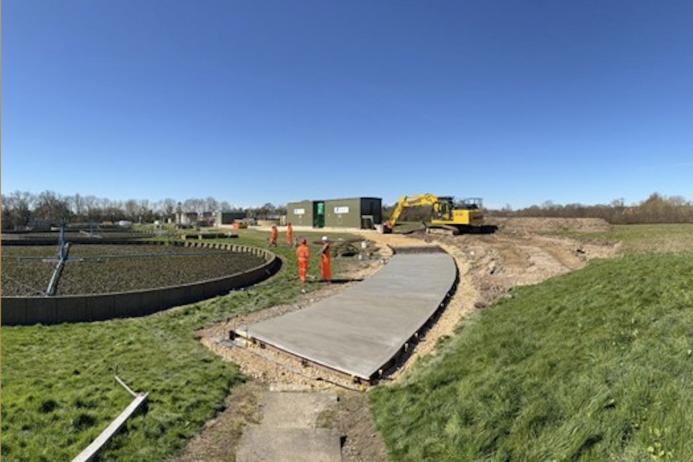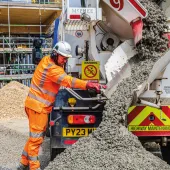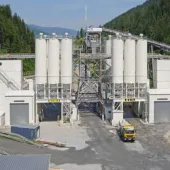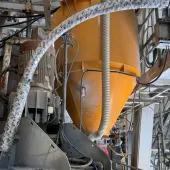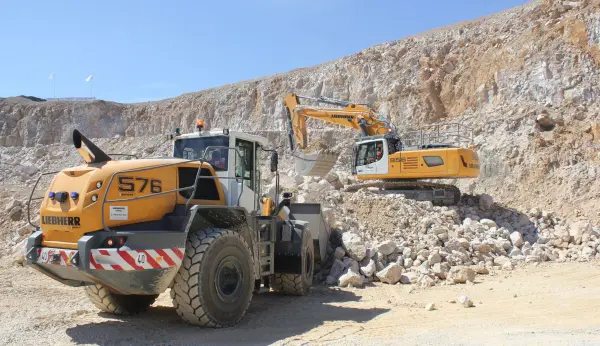Graphene-enhanced concrete success for Cemex
Novel lower-carbon concrete with graphene-based addition successfully laid at Northumbrian Water site
A NOVEL concrete formulation developed through collaboration between the Graphene Engineering Innovation Centre (GEIC) at the University of Manchester, Cemex UK, Galliford Try, Sika, and Northumbrian Water has been successfully laid on site, delivering a major milestone in efforts to decarbonize construction materials.
The project culminated in the successful pour of 15m3 of graphene and micronized lime-enhanced concrete at a Northumbrian Water wastewater treatment facility. This mix achieved up to 49% reduction in CO2 emissions per cubic metre compared with traditional CEM I concrete, while maintaining comparable compressive strength performance.
The lower-carbon concrete, known as CoMLaG (Combining Micronized Limestone and Graphene), was developed and trialled at the GEIC and Cemex’s National Technical Centre. The mix uses a ternary cement blend, replacing a portion of the high-carbon clinker with ground granulated blast-furnace slag (ggbs) and micronized limestone. To counter the strength losses typically associated with clinker reduction, a graphene-based addition formulated at GEIC was introduced to enhance strength development.
Following extensive lab trials, the project team scaled production through a batch plant in the North East of England using site-available aggregates and raw materials. The successful site application demonstrated the real-world viability of the mix and laid the foundation for future optimization and deployment.
The April 2025 slab pour was monitored using Cemex’s i-Con maturity monitoring system, which provided real-time data on curing conditions and strength gain, helping validate the concrete’s performance under actual site conditions.
Slump and compressive strength tests showed results consistent with lab data. The cement blend with graphene achieved a 28-day compressive strength of 78.3N/mmm2, closely matching the 82.6N/mm2 of the CEM I control. While early-age strength values were lower due to reduced clinker content, the inclusion of graphene helped narrow the gap, demonstrating comparable performance to industry standards but with a significant reduction in CO2 emissions.
This collaborative effort demonstrates the potential of advanced material science to support the construction sector’s net-zero ambitions. The GEIC’s work to formulate and stabilize the graphene additive was central to ensuring performance at very low dosing levels (<0.1% by weight of cementitious content), while Cemex and Galliford Try enabled the transition from lab to large-scale pour.
‘This is a fantastic example of an industry-led project with significant contributions from University of Manchester research facilities to reduce carbon emissions in construction,’ said Lisa Scullion, application manager at the GEIC. ‘Graphene-enhanced systems like CoMLaG open the door to concrete that performs well while significantly cutting its environmental impact.’
Mike Higgins, director of quality and product technology at Cemex, said: ‘At Cemex, we are committed to pioneering sustainable construction solutions, and this project exemplifies that mission. The successful deployment of the CoMLaG project on a live site demonstrates how the use of advanced materials can help us reduce carbon emissions whilst remaining focused on performance. Collaborating with partners like the GEIC, Galliford Try, and Northumbrian Water has been instrumental in accelerating the transition from lab innovation to real-world application.’
The next phase of work will focus on optimizing the mix, improving admixture compatibility, and validating performance across a wider range of aggregates to support commercial rollout.
This successful collaboration between the GEIC, Cemex, Galliford Try, Sika, and Northumbrian Water demonstrates how research and industry partnerships can drive meaningful progress in sustainable construction. Together, the partners are paving the way for lower-carbon concrete solutions that balance performance with environmental responsibility.

